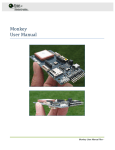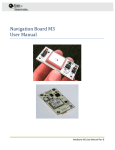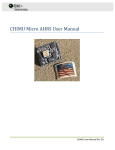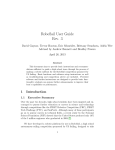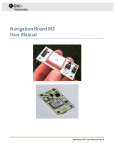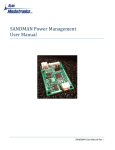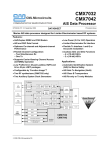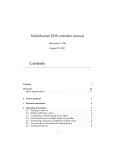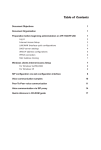Download X-Monkey User Manual
Transcript
X-Monkey User Manual X-Monkey User Manual Rev - Table of Contents Contents 1. Introduction ................................................................................................................................ 3 1.1 Limitations .......................................................................................................................... 4 1.1.1 Rate limits ..................................................................................................................... 4 1.1.2 Acceleration limits ......................................................................................................... 4 1.1.3 Magnetic field limits....................................................................................................... 4 1.1.4 GPS .............................................................................................................................. 5 1.1.5 Precautions and User Responsibility ............................................................................. 5 1.2 Theory of Operation ............................................................................................................ 5 1.2.1 Startup Conditions ........................................................................................................ 6 2. Specifications and Characteristics .............................................................................................. 7 2.1 Performance Specifications – CPU ..................................................................................... 7 2.2 Performance Specifications – Global Positioning Receiver ................................................. 7 2.3 Electrical Characteristics – Monkey .................................................................................... 7 2.4 Absolute Maximum Ratings ................................................................................................ 8 2.5 Mechanical and Pin Assignments ....................................................................................... 9 2.5.1 Dimensions ................................................................................................................... 9 2.5.2 Coordinate System and Orientation .............................................................................. 9 2.5.3 Pin Assignments ......................................................................................................... 10 2.5.4 Physical Location of Connectors ................................................................................. 14 3. Schematic Details..................................................................................................................... 18 3.1 Main ARM Processor ........................................................................................................ 18 3.2 Power Input ...................................................................................................................... 18 3.3 Servo Output .................................................................................................................... 19 3.4 GPS Power and Antenna .................................................................................................. 19 3.5 Reprogramming ................................................................................................................ 20 3.6 USB .................................................................................................................................. 20 3.7 LEDs ................................................................................................................................ 20 3.8 Barometric Pressure Sensor ............................................................................................. 20 3.9 Accelerometers and Magnetometers ................................................................................ 21 3.10 Rate sensors .................................................................................................................... 21 3.11 MPU-9150 ........................................................................................................................ 22 3.12 ADC and GPIO ................................................................................................................. 22 3.13 Communication ports ........................................................................................................ 22 3.14 Input Capture port and Aux Connector ............................................................................. 24 3.15 Memory and Storage ........................................................................................................ 24 4. Hardware Integration ................................................................................................................ 25 4.1 Power ............................................................................................................................... 25 4.1.1 Input Power ................................................................................................................ 25 4.2 GPS Antenna Options ...................................................................................................... 25 5. Software Interface .................................................................................................................... 26 5.1 Recommended tools ......................................................................................................... 26 5.2 Firmware Upload Procedure ............................................................................................. 26 6. Appendix A – Reprogramming Example ................................................................................... 27 X-Monkey User Manual Rev - Release Notes Title Subtitle Type Document number Revision Index Initial Release Monkey X-Monkey User Manual Manual UM5000 Date 4/2012 Name MR Status / Comments Initial release IMPORTANT DISCLAIMERS This document and the use of any information contained therein, is subject to the acceptance of the Ryan Mechatronics terms and conditions. They can be downloaded from www.ryanmechatronics.com. Ryan Mechatronics LLC makes no warranties based on the accuracy or completeness of the contents of this document and reserves the right to make changes to specifications and product descriptions at any time without notice. Ryan Mechatronics LLC assumes no liability for damages or otherwise due to use of the information in this document or application of any device described in this document. Ryan Mechatronics LLC stresses end user compliance with all applicable laws and regulations when using devices of this nature. Use by an end user in violation of any applicable laws is automatic basis for termination of warranty, technical support and future sales. Ryan Mechatronics LLC reserves all rights to this document and the information contained herein. Reproduction, use or disclosure to third parties without express permission is strictly prohibited. Copyright © 2012, Ryan Mechatronics LLC X-Monkey User Manual Rev - 1. Introduction The Monkey platform provides a high performance basis for mechatronic system control. Originally designed for autonomous vehicle control, the platform can also be used for advanced data logging, industrial control, motion control or other mechatronic applications. The X-Monkey platform is an enhanced version of prior Monkey circuit assemblies. The X-Monkey includes: o o Powerful base CPU - Cortex M3 (ARM7) LPC 1768 Host Controller o Cortex SWD interface (tested with Rowley Crossworks) o Hardware based serial boot loader for easy loading of new software High performance U-Blox LEA-6 GPS Module o Active on board antenna for increased sensitivity and jamming reduction o Autosensing off board GPS antenna switch for external antenna use o 3 axis gyro (rate sensor) o 3 axis accelerometer o 3 axis magnetometer o RS-485 driver on board for spare port o Barometric pressure sensor o Spare analog and digital I/O ports o Six (6) Isolated and dedicated PWM servo outputs o Four (4) input capture port connector o Micro SD Card o EEPROM for configuration settings o Flash data log for solid state data logging o Three status LED’s (red, green, blue) o Interfaces with CHIMU module for attitude estimates and sensor inputs via SPI or UART Monkey has an excellent GPS module on board (U-Blox series) with both on board and off board antenna capability. The off board antenna capability is important if the unit is used in conditions where the on board antenna will be blocked by enclosures or other jamming. X-Monkey User Manual Rev - | Introduction 3 Monkey has on board inertial measurement sensors, but is intended to work with the CHIMU AHRS as a plug in module to offload attitude determination. The CHIMU includes: 3 axis rate sensors to measure angular rate 3 axis accelerometers to measure linear acceleration 3 axis magnetometer to measure magnetic flux (typically used for compass type heading derivation) The combination of all these capabilities with the on board ARM processing power allows a full attitude heading reference system (AHRS) with GPS position, velocity and time updates all in one tiny package. Application areas include, but are not limited to: UAVs (AUVs, UAS, etc) Robotics Education Rocket science 1.1 Limitations The unit, like any device designed to utilize GPS and IMU / AHRS data, can be pushed beyond the limits of its ability to sense any of the measurements it needs to operate correctly. The following list includes results that are known to occur if operation (when using the CHIMU module) exceeds the limits listed later in this document. 1.1.1 Rate limits Saturation of maximum rate in any axis for any amount of time will result in an incorrect attitude estimate. The longer the saturation duration, the more error will be present in the attitude determination. A good attitude estimator shall recover once saturation has stopped and the internal filter has time to reconverge on the correct solution. Please note: The Monkey does NOT ship with an attitude estimator set of code, but it has the processing and code memory to host an estimator of the customers design and use raw output from the CHIMU module or the on board sensors. 1.1.2 Acceleration limits Excessive acceleration can include acceleration above the rated levels in continuous application (static / low frequency g’s), more elusive vibration (sinusoidal / random) or shock (impulse / random) events that may not show full saturation of the accelerometers in data output, but have affected the sensors internally and corrupted the values. Continued acceleration above the limits or excessive vibration / shock events can corrupt the output acceleration. 1.1.3 Magnetic field limits Magnetometers are sensitive to hard and soft iron effects, as well as induced magnetic fields from high current. Saturation of the local magnetic field is easily identified, but lower level influence on the sensor can result in pervasive errors as well. Calibration of the unit in the final configuration will help prevent errors introduced by hard iron in the local area. However, induced magnetic fields from high current devices or high power RF circuitry can result in operational errors. After a proper calibration, no axis should exceed a +/- 1 gauss value. X-Monkey User Manual Rev - | Introduction 4 1.1.4 GPS GPS is a phenomenal technology allowing location of your position on the planet Earth within about a 15 foot (5 meter) accuracy using a module the size of your thumb! GPS is subject to many possible interference sources, including anything in the GPS frequency band (including harmonics of lower frequencies from digital systems) and other jamming sources, like foliage or direct blockage of the antenna. This manual cannot begin to educate the user on limits of GPS technology, but we recommend both Wikipedia and the support area on the U-blox (www.ublox.com) website for more information. 1.1.5 Precautions and User Responsibility The Monkey is an open electrical device with no case. It has no on board protection from short circuits or accidental electrical damage. No system is fool proof, and all correct use and planning for events in case of failure are the responsibility of the user. Ryan Mechatronics cannot be held responsible for accidental or intentional damage caused by this unit either directly or indirectly. 1.2 Theory of Operation The Monkey platform is an excellent prototyping system for users that want or need the power of an ARM Cortex core. User application code can be run on the core. However, the design makes it easy for the on-board ARM processor to be reprogrammed by using on-board firmware upload capability. This allows new Intel HEX formatted code to be uploaded using the serial port. A top level view of the usage modes is shown in the following figure. X-Monkey User Manual Rev - | Introduction 5 Figure 1. Boot Options 1.2.1 Startup Conditions The startup condition of the S2 ISP pushbutton on the Monkey dictates what mode the system enters when reset or power is applied. On Board ARM CPU running user code: For operation in standalone mode, user must have code loaded and running on the processor. In this case, switch S2 is not depressed. Reprogramming: In order to reprogram the board, switch S2 would be depressed before power is applied. When power is applied in this state, the on board boot loader of the ARM is active. Programming steps in this state can be found in Appendix A – Reprogramming Example . X-Monkey User Manual Rev - | Introduction 6 2. Specifications and Characteristics Presented in this section are the sensor and system specifications for the Monkey. All parameters specified are @ VDD = 3.3 V and Ta = 25°C. 2.1 Performance Specifications – CPU The performance specifications of the LPC1768 core processor are too numerous and detailed to reproduce here. Please see the following link for specific information on the LPC1768: http://www.nxp.com/documents/data_sheet/LPC1769_68_67_66_65_64_63.pdf 2.2 Performance Specifications – Global Positioning Receiver Characteristics Conditions Min Typical 2 29 29 <1 <2.5 <2.0 2 Max Units Position, Velocity and Time Time to First Fix Horizontal position accuracy Max Navigation Update Rate Velocity accuracy External antenna power supply Cold Start Warm Start Hot Start Without SBAS SBAS Message dependent Center feed on external antenna connection s m 5 Hz 0.1 m/s 3.3 V Specifications are subject to change at any time without notice 2.3 Electrical Characteristics – Monkey The following electrical characteristics relate to the Monkey board with a CHIMU module attached. Current draw is heavily dependent on code operation. Characteristics Conditions Min Typical Max Units Power Input Supply Voltage Range Vdd Referenced to GND 4.5 5.0 28 V Current Average, measured at 5V 110 130 150 mA 48 MHz core operation GPS in signal acquisition (track results in lower current) CHIMU running SD card logging 10 Hz data at 1 Hz intervals PWM active Specifications are subject to change at any time without notice X-Monkey User Manual Rev - | Specifications and Characteristics 7 2.4 Absolute Maximum Ratings Parameter Rating Acceleration (any axis, 0.5 ms) Unpowered Vdd 2000g Output Short-Circuit Duration (Any Pin to Common) Operating Temperature Range TBD Storage Temperature Range -40°C to +125°C -0.3V to +28V -30°C to +85°C Specifications are subject to change at any time without notice Stresses above those listed under the Absolute Maximum Ratings may cause permanent damage to the device. This is a stress rating only; functional operation of the device at or near these or any other conditions above those indicated in the operational section of this specification is not implied. Exposure to absolute maximum rating conditions for extended periods of time may affect device reliability. Drops onto hard surfaces can cause shocks of greater than 2000 g and can exceed the absolute maximum rating of the device. Exercise care during handling to avoid damage. X-Monkey User Manual Rev - | Specifications and Characteristics 8 2.5 Mechanical and Pin Assignments 2.5.1 Dimensions Dimensions and outline for the unit are shown below. All units are in inches. Figure 2. Mechanical Dimensions Mounting holes are designed to accommodate standard 4-40 screw sizes. 2.5.2 Coordinate System and Orientation The Monkey board does not have a coordinate system of its own, but when used with the CHIMU attitude estimator, it follows a standard (X/Y/Z) coordinate system as shown, where +X is out the “nose” of the Monkey board, +Y is to the right, and +Z points down. X-Monkey User Manual Rev - | Specifications and Characteristics 9 2.5.3 Pin Assignments Shown in this section are names for each of the signals on the Monkey connectors, along with warnings / information as applicable. Table 1 – User Connector Overview Connector ID J1 Connector Name / Function Main Power Description J2 SWD SV1 Servo Output 1-2 PWM output (isolated) for servo channels 1 and 2 SV2 Servo Output 3-4 PWM output (isolated) for servo channels 3 and 4 SV3 Servo Output 5-6 PWM output (isolated) for servo channels 5 and 6 X1 Main Com X2 ADC/GPIO X3 Spare serial and CHIMU serial ports Primary power input to the system and input for battery voltage monitoring Serial Wire Debug interface to ARM processor 3.3V level serial port UART0 (primary com port to / from Monkey) Four (4) ADC inputs (2 buffered and 2 un-buffered) and two (2) GPIO lines Two (2) 3.3V level serial ports. Spare port is routed to RS-485 output if selected by software. X4 Input Capture and Aux Connector X5 Remote ISP U9 CHIMU CHIMU serial port available for output if CHIMU configured for SPI com only Four (4) input capture ports for servo PWM input capture. Can also be reconfigured for added GPIO. User dedicated I2C bus also. Spare port for ISP (serial port reprogramming) and battery backup Allows plug in of CHIMU attitude estimator module Table 2 - Pin Assignments J1 – Primary Power Pin # 1 Pin Label on board VIN Pin Name Vin I/O Description N/A 4.5 to 28V input power 2 GND Ground N/A System ground X-Monkey User Manual Rev - | Specifications and Characteristics 10 Table 3 - Pin Assignments J2 – Serial Wire Debug (SWD) Pin # Pin Name I/O 1 Pin Label on board - Description 3.3V Power 2 - TMS/SWDIO I/O SWD standard 3 - GND Ground System ground 4 - TCK/SWCLK I/O SWD standard 5 - GND Ground System ground 6 - TDO/SWO I/O SWD standard 7 - RTCK I/O SWD standard 8 - TDI I/O SWD standard 9 - GND Ground System ground 10 - !RESET I/O SWD standard 3.3V power Table 4 - Pin Assignments SV1 – Servo Output 1/2 Pin # 1 Pin Label on board 1 Pin Name Servo 1 Output Servo 2 Output Servo5V 2 - 3 - 4 - 5 - 6 6 GndServo I/O Description O PWM output for Servo 1 O PWM output for Servo 2 Power Servo 5V supply Servo5V Power Servo 5V supply GndServo Ground Servo Ground Ground Servo Ground Servo 5V and Servo Ground are isolated from main system and ground. This can be defeated by jumping SJ3 and SJ4. Table 5 - Pin Assignments SV2 – Servo Output 3/4 Pin # 1 Pin Label on board 1 2 - 3 - Pin Name Servo 3 Output Servo 4 Output Servo5V I/O Description 4 - Servo5V Power Servo 5V supply 5 - GndServo Ground Servo Ground 6 6 GndServo Ground Servo Ground O PWM output for Servo 3 O PWM output for Servo 4 Power Servo 5V supply Servo 5V and Servo Ground are isolated from main system and ground. This can be defeated by jumping SJ3 and SJ4. X-Monkey User Manual Rev - | Specifications and Characteristics 11 Table 6 - Pin Assignments SV3 – Servo Output 5/6 Pin # 1 Pin Label on board 1 2 - 3 - Pin Name Servo 5 Output Servo 6 Output Servo5V I/O Description 4 - Servo5V Power Servo 5V supply 5 - GndServo Ground Servo Ground 6 6 GndServo Ground Servo Ground O PWM output for Servo 5 O PWM output for Servo 6 Power Servo 5V supply Servo 5V and Servo Ground are isolated from main system and ground. This can be defeated by jumping SJ3 and SJ4. Table 7 - Pin Assignments X1 – Main Serial Com Pin # 1 Pin Label on board 3.3V A Pin Name 3.3V Aux I/O Description Power 3.3V auxiliary output from on board LDO 2 G GND Ground System ground 3 RX COM_RX I/O UART RX0 (3.3V level) 4 TX COM_TX I/O UART TX0 (3.3V level) For ARM pins, typical use is shown but can be reconfigured. Please see the LPC1768 User Manual from NXP for other pin options. Table 8 - Pin Assignments X2 – ADC/GPIO Pin # Pin Name I/O Description 1 Pin Label on board GP1 GPIO1 I/O 270 ohm current limited I/O to ARM 2 GP0 GPIO0 I/O 270 ohm current limited I/O to ARM 3 A4 ADC4 ADC Unbuffered ADC4 to ARM. Do not exceed 3.3V. 4 A3 ADC3 ADC Unbuffered ADC3 to ARM. Do not exceed 3.3V. 5 3.3 3.3V Power 6 G GND Ground 7 A1 ADC1 ADC 8 A0 ADC0 ADC 3.3V output from primary on board LDO for use in powering external signal conditioning or sensors System ground Buffered ADC1 to ARM. Buffer is a passive resistor divider (4.7k on each leg) that cuts incoming voltage by a factor of 2. 5V input on this line reduced to 2.5V which is within 3.3V limit of ADC. Buffered ADC0 to ARM. Buffer is a passive resistor divider (4.7k on each leg) that cuts incoming voltage by a factor of 2. 5V input on this line reduced to 2.5V which is within 3.3V limit of ADC. For ARM pins, typical use is shown but can be reconfigured. Please see the LPC1768 User Manual from NXP for other pin options. X-Monkey User Manual Rev - | Specifications and Characteristics 12 Table 9 - Pin Assignments X3 – Spare Serial Communication Pin # Pin Name I/O 1 Pin Label on board U1-RX Description SP_RX I/O UART1 RX1 (3.3V level) 2 U1-TX SP_TX I/O UART1 TX1 (3.3V level) 3 CTS1 SP_CTS1 I/O UART1 CTS1 4 RTS1 I/O UART1 RTS or RS-485 TX enable line 5 3.3V A SP_485_TXENABLE / RTS1 3.3V Aux Power 3.3V output from auxiliary on board LDO for use in powering external signal conditioning or sensors System ground 6 G GND Ground 7 U3-RX UART3_RX I/O UART RX3 (3.3V level) 8 U3-TX UART3_TX I/O UART TX3 (3.3V level) 9 485-B RS485_B I/O RS 485 B differential signal 10 485-A RS485_A I/O RS-485 A differential signal For ARM pins, typical use is shown but can be reconfigured. Please see the LPC1768 User Manual from NXP for other pin options. Table 10 - Pin Assignments X4 – Input Capture and Aux Connector Pin # Pin Name CAP 1.0 I/O 1 Pin Label on board Cap 1.0 Description I/O Capture pin 1.0 2 Cap 1.1 CAP 1.1 I/O Capture pin 1.1 3 Cap 0.0 CAP 0.0 I/O Capture pin 0.0 4 Cap 0.1 CAP 0.1 I/O Capture pin 0.1 5 - N/C N/C N/C N/C 6 - N/C N/C 7 3.3V 3.3V Power 3.3V primary output from on board LDO. 8 GND GND Ground System ground 9 SDA2 SDA2 I/O I2C SDA line to ARM. 4.7k pull-up to 3.3V on board. 10 SCL2 SCL2 I/O I2C SCL line to ARM. 4.7k pull-up to 3.3V on board. For ARM pins, typical use is shown but can be reconfigured. Please see the LPC1768 User Manual from NXP for other pin options. Table 11 - Pin Assignments X5 – Remote ISP Pin # Pin Name I/O 1 Pin Label on board 3.3V Description 3.3V Power 3.3V primary output from on board LDO 2 VBAT VBAT Power Battery backup to ARM processor if required 3 GND GND Ground System ground 4 ISP ISP_PDOWN I/O ISP – Pull down on boot to engage serial bootloader X-Monkey User Manual Rev - | Specifications and Characteristics 13 2.5.4 Physical Location of Connectors Reprinted here is the silkscreen for the Monkey board top and bottom artwork. Locations of all components and connectors can be found here. Also shown is the correct orientation for plugging a servo motor into the X-Monkey board. 2.5.4.1 Top Side Figure 3. Top side connections X-Monkey User Manual Rev - | Specifications and Characteristics 14 Figure 4. Top side description X-Monkey User Manual Rev - | Specifications and Characteristics 15 2.5.4.2 Bottom Side Figure 5. Bottom side connections X-Monkey User Manual Rev - | Specifications and Characteristics 16 Figure 6. Bottom side descriptions Figure 7. Proper servo connection example X-Monkey User Manual Rev - | Specifications and Characteristics 17 3. Schematic Details Presented in this section are schematic details required for users to correctly program the board for alternate applications. 3.1 Main ARM Processor Pins for the ARM connection are shown below for reference. 3.2 Power Input Main power input can operate from 4.5 to 28 V input. X-Monkey User Manual Rev - | Schematic Details 18 3.3 Servo Output 3.4 GPS Power and Antenna Unlike previous Monkey builds, GPS power is controlled only by a software pin interface. Also, there is an auto detect switch on board that automatically shifts from the on board active antenna to the external antenna if there is an active external antenna plugged in. . X-Monkey User Manual Rev - | Schematic Details 19 3.5 Reprogramming SWD connector J2 is shown here. It is a standard Cortex SWD connection. 3.6 USB USB communication is not part of Monkey code. No USB connectors are present on the X-Monkey. 3.7 LEDs LEDs (green, red and blue) are controlled by the ARM. Power is supplied by the auxiliary 3.3V supply to allow greater power savings if you disable the LED supply. 3.8 Barometric Pressure Sensor The barometric pressure sensor is light sensitive, and is located under the CHIMU module holder. X-Monkey User Manual Rev - | Schematic Details 20 3.9 Accelerometers and Magnetometers X-Monkey has an on board, 3 axes, combined accelerometer and magnetometer sensor, the LSM303. 3.10 Rate sensors X-Monkey has an on board 3 axes rate sensor, the ITG-3050. X-Monkey User Manual Rev - | Schematic Details 21 3.11 MPU-9150 X-Monkey has pads that allow an MPU-9150 to be installed. This component is new, and is not yet on the stock X-Monkey. 3.12 ADC and GPIO Connector X1 is a mix of ADC (buffered and unbuffered) and GPIO signals. 3.13 Communication ports Main com is on X1, this is UART 0. Spare com (UART1) and UART3 (formerly called “CHIMU com”) are on connector X3. UART1 can be routed thru the RS-485 driver to the same connector. The RS485 chip can be completely turned off via power control to the chip to save power in sleep modes. X-Monkey User Manual Rev - | Schematic Details 22 X-Monkey User Manual Rev - | Schematic Details 23 3.14 Input Capture port and Aux Connector Input capture (or GPIO if desired) connection is on X4. Also on this port is the user I2C port (I2C2) and spare ground and 3.3V for external use. 3.15 Memory and Storage X-Monkey has three different memory / storage capabilities. Micro SD card, data flash (solid state memory) and an I2C EEPROM for reading / writing configuration settings. X-Monkey User Manual Rev - | Schematic Details 24 4. Hardware Integration Presented in this section are selected hardware interface comments to help ease integration of the unit in the end user system. Please note - the Monkey is an open electrical device with no case. It has no on board protection from short circuits or accidental electrical damage. No system is fool proof, and all correct use and planning for events in case of failure are the responsibility of the user. Ryan Mechatronics cannot be held responsible for accidental or intentional damage caused by this unit either directly or indirectly. 4.1 Power 4.1.1 Input Power Input power to the board is 4.5 to 28V but the Monkey core electronics all operate internally off of 3.3V generated via an on board low dropout linear regulators. Critical Warning: There are jumpers that allow you to send input power to the servo connectors. If you jump these, the servo isolation is defeated. However, more critically, you must limit your input voltage to the maximum servo voltage (typically 5V). 4.2 GPS Antenna Options The Monkey has an on board active patch antenna for GPS reception. It also has an external antenna attachment. On board circuitry automatically switches to the external antenna if attached. X-Monkey User Manual Rev - | Hardware Integration 25 5. Software Interface A set of core Monkey base software is available as a mixed open source / proprietary library set and can be found at www.ryanmechatronics.com. Monkey is intended for developers, so all functionality, while tested, may not be included in this source code. Any missing desired code is the responsibility of the user and not the responsibility of Ryan Mechatronics. 5.1 Recommended tools We highly recommend using Rowley Crossworks (http://www.rowley.co.uk) Crossworks for ARM as the tool for reprogramming the Monkey. Rowley tools are very simple to use and based on the GCC compiler chain. In addition to the Crossworks package, the CrossConnect LITE and SWD adapter should be purchased if debugging on board using the SWD connector is planned. 5.2 Firmware Upload Procedure Firmware can be uploaded using the SWD connector and suitable Cortex debugging tools, or it can be uploaded via the serial port as an Intel HEX formatted file. An example of uploading firmware via this method can be found in Appendix A – Reprogramming Example. X-Monkey User Manual Rev - | Software Interface 26 6. Appendix A – Reprogramming Example Steps to load a new Hex file (firmware image) into the Monkey 2010 board 1) 2) 3) 4) 5) 6) 7) 8) 9) 10) 11) 12) Download and install the latest version of FlashMagic from this site: (http://www.flashmagictool.com/) Power down Monkey Remove CHIMU module (if present) from Monkey board (to be on the safe side) Plug USB node or other USB to serial converter into Monkey Press the S2 button on Monkey and KEEP IT HELD DOWN FOR THE NEXT STEP! Power up Monkey (or, press the S1 button and release it) Release the S2 button. Run FlashMagic and reprogram a. Open settings file (.fms), or if .fms file is not available, select settings shown below b. Change COM port to your com port c. Change path to .hex file to where you stored the hex file to download d. Press the “start” button, it will flash and verify e. If it fails, try pressing the reset button on the Monkey board and try again f. If it still fails, try powering the unit via a USB cable so grounds are common g. If it still fails, drop the baud rate to 57600 h. If it still fails, cycle power on the Monkey and try again Close FlashMagic Power board down Put CHIMU back on (be CAREFUL ABOUT PIN ALIGNMENT!) Power up without any buttons pressed and verify new code is running X-Monkey User Manual Rev - | Appendix A – Reprogramming Example 27




























